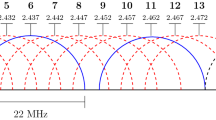Abstract
Channel assignment problems in multi-radio wireless mesh networks (WMNs) have been shown to be NP-hard in various scenarios in the literature. By far, most of research efforts have focused on developing efficient approximation algorithms that run reasonably fast and provide good quality channel assignment rather than the optimal one. However, from the practical network design and deployment standpoint, engineers care more about whether it is feasible to optimally assign channels in the simplest way (i.e., exhaustive search), as most of existing commercial WMNs are of small/medium scale. In this paper, we attempt to answer this practical question. We study the complexity of general channel assignment problems with certain basic and common properties. The results show that the complexity in terms of the number of different possible assignments is exponential in the number of wireless links. Furthermore, we estimate the theoretical runtime of determining the optimal channel assignment by exhaustive search and validate it through experiments. We show that, given certain computing power (e.g., an off-the-shelf notebook PC), it is feasible to optimally solve channel assignment problems in small-scale and medium-scale commercial multi-radio WMNs. In other words, approximation algorithms are not needed for most of current commercial WMNs.
Similar content being viewed by others
References
Gast, M. S. (2005). 802.11 wireless networks: the definitive guide (2nd ed.). Sebastopol: O’Reilly Media.
Akyildiz, I. F., Wang, X., & Wang, W. (2005). Wireless mesh networks: a survey. Computer Networks Journal (Elsevier), 47(3), 445–487.
Bahl, P., Adya, A., Padhye, J., & Wolman, A. (2004). Reconsidering wireless systems with multiple radios. ACM Computer Communication Review, 34(10), 39–46.
Kyasanur, P., & Vaidya, N. H. (2005). Capacity of multi-channel wireless networks: Impact of number of channels and interfaces. In Proc. of ACM MobiCom. Cologne, Germany, September 2005.
Subramanian, A. P., Gupta, H., & Das, S. R. (2007). Minimum interference channel assignment in multi-radio wireless mesh networks. In Proc. of IEEE SECON. San Diego, California, June 2007.
Bahl, P., Chandra, R., & Dunagan, J. (2004). SSCH: slotted seeded channel hopping for capacity improvement in IEEE 802.11 ad hoc wireless networks. In Proc. of ACM MobiCom. Philadelphia, PA, October 2004.
So, J., & Vaidya, N. H. (2004). Multi-channel MAC for ad hoc networks: Handling multi-channel hidden terminals using a single transceiver. In Proc. of ACM MobiHoc. Tokyo, Japan, May 2004.
Kodialam, M., & Nandagopal, T. (2005). Characterizing the capacity region in multi-radio multi-channel wireless mesh networks. In Proc. of ACM MobiCom. Cologne, Germany, September 2005.
Marina, M., & Das, S. (2005). A topology control approach for utilizing multiple channels in multi-radio wireless mesh networks. In Proc. of Broadnet. Boston, MA, October 2005.
Raniwala, A., & Chiueh, T. (2005). Architecture and algorithms for an IEEE 802.11-based multi-channel wireless mesh network. In Proc. of IEEE Infocom. Miami, FL, March 2005.
Raniwala, A., Gopalan, K., & Chiueh, T. (2004). Centralized channel assignment and routing algorithms for multi-channel wireless mesh networks. ACM Mobile Computing and Communications Review, 8(4), 50–65.
Xie, W., Xiao, M., Zhao, F., & Yao, Y. (2007). Implementation and evaluation of channel assignment tool for multi-radio multi-channel wireless mesh networks. In Proc. of IEEE WCNC. Hong Kong, China, March 2007.
Tang, J., Xue, G., & Zhang, W. (2005). Interference-aware topology control and QoS routing in multi-channel wireless mesh networks. In Proc. of ACM MobiHoc. Urbana-Champaign, IL, May 2005.
Alicherry, M., Bhatia, R., & Li, L. E. (2005). Joint channel assignment and routing for throughput optimization in multi-radio wireless mesh networks. In Proc. of ACM MobiCom. Cologne, Germany, September 2005.
Mohsenian-Rad, A. H., & Wong, V. W. S. (2006). Logical topology design and interface assignment for multi-channel wireless mesh networks. In Proc. of IEEE Globecom. San Francisco, CA, November 2006.
Mohsenian-Rad, A. H., & Wong, V. W. S. (2006). Joint optimal channel assignment and congestion control in multi-radio wireless mesh networks. In Proc. of IEEE ICC. Istanbul, Turkey, June 2006.
Mohsenian-Rad, A. H., & Wong, V. W. S. (2007). Joint optimal channel allocation, interface assignment, and MAC design for multi-channel wireless mesh networks. In Proc. of IEEE Infocom. Anchorage, AK, May 2007.
Lin, X., & Rasool, S. (2007). A distributed joint channel-assignment, scheduling and routing algorithm for multi-channel ad hoc wireless networks. In Proc. of IEEE Infocom. Anchorage, AK, May 2007.
Mohsenian-Rad, A. H., & Wong, V. W. S. (2007). Partially overlapped channel assignment for multi-channel wireless mesh networks. In Proc. of IEEE ICC. Glasgow, Scotland, June 2007.
Mishra, A., Shrivastava, V., Banerjee, S., & Arbaugh, W. (2006). Partially overlapped channels not considered harmful. In Proc. of ACM SIGMetric. Saint Malo, France, June 2006.
Naveed, A., Kanhere, S. S., & Jha, S. K. (2007). Topology control and channel assignment in multi-radio multi-channel wireless mesh networks (Technical Report UNSW-CSE-TR-0711). The University of New South Wales, Sydney, Australia, May 2007.
Das, S. M., Pucha, H., Koutsonikolas, D., Hu, Y. C., & Peroulis, D. (2006). DMesh: Incorporating practical directional antennas in multi-channel wireless mesh networks. IEEE Journal on Selected Areas in Communications (JSAC), 24(11), 2028–2039, special issue on Multi-Hop Wireless Mesh Networks.
Caprara, A., Kellerer, H., & Pferschy, U. (2000). The multiple subset sum problem. SIAM Journal on Optimization, 11.
Holyer, I. (1981). The NP-completeness of edge-coloring. SIAM Journal of Computing, 10.
Frieze, A., & Jerrum, M. (1997). Improved approximation algorithms for max k-cut and max bisection. Algoritmica, 18.
Brualdi, R. A. (2005). Introductory combinatorics (4th ed.). London: Pearson Education.
Author information
Authors and Affiliations
Corresponding author
Rights and permissions
About this article
Cite this article
Xie, W., Zhang, Y.J.(., Sichitiu, M.L. et al. Feasibility of optimally assigning channels by exhaustive search in commercial multi-radio wireless mesh networks. Telecommun Syst 44, 171–178 (2010). https://doi.org/10.1007/s11235-009-9216-3
Published:
Issue Date:
DOI: https://doi.org/10.1007/s11235-009-9216-3




